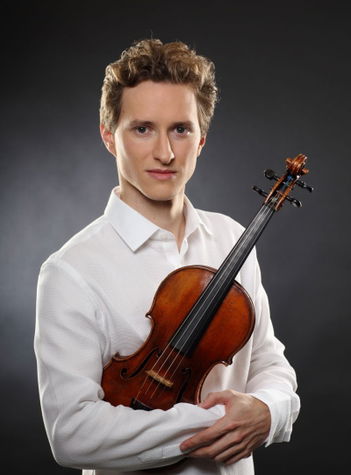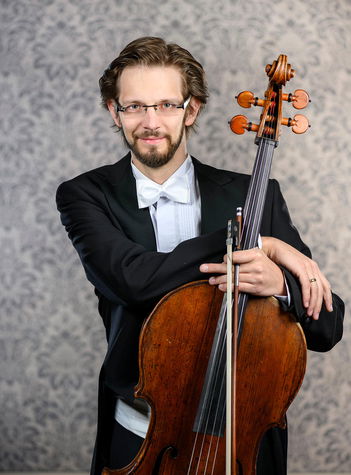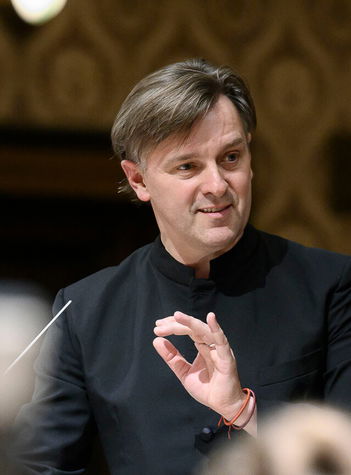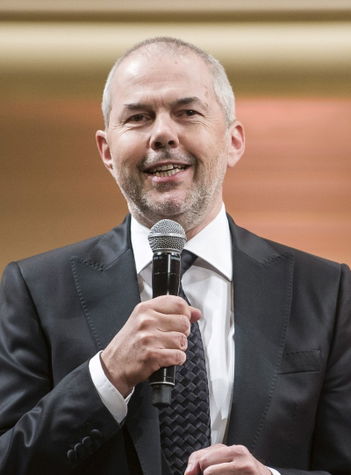1 / 6
Czech Philharmonic • New Year’s Concerts
For this season’s New Year’s Eve and New Year’s Day concerts led by Tomáš Netopil, the Czech Philharmonic returns to music of the turn of the 19th and 20th centuries - the “belle époque” - when French music crossed the boundary of traditional aesthetics and thrilled listeners with beautiful melodies, grand Romanticism, and of course, Impressionism. Let’s dance together into the New Year with charm and elegance!
Programme
Camille Saint-Saëns
Bacchanale from the opera Samson et Dalila, Op. 47 (7' 20)
Gabriel Fauré
Sicilienne from the suite Pelléas et Mélisande, Op. 80 (3' 30)
Eugène Ysaÿe
Caprice d’après l’étude en forme de valse de Saint-Saëns, Op. 52 (9')
Francis Poulenc
Rondeau from the suite Les biches (3' 30)
Camille Saint-Saëns
Cello Concerto No. 1 in A minor, Op. 33 (10')
Gabriel Fauré
Pavane, Op. 50 (7')
Francis Poulenc
Rag-mazurka from the suite Les biches (4')
Jules Massenet
Meditation, symphonic intermezzo from the opera Thaïs (5')
Maurice Ravel
La Valse (12')
Performers
Josef Špaček violin
Ivan Vokáč cello
Tomáš Netopil conductor
Czech Philharmonic
Marek Eben moderator (for 1 January 2025 concerts only)

Customer Service of Czech Philharmonic
Tel.: +420 227 059 227
E-mail: info@czechphilharmonic.cz
Customer service is available on weekdays from 9.00 am to 6.00 pm.
*Marek Eben moderates only concerts on 1. 1. 2025.
From the latter half of the 19th century to the early 20th, French classical music enjoyed one of its richest periods. This era, often called the “belle époque”, was a time of creative blossoming, innovation, and a search for new means of expression. Composers like Claude Debussy, Gabriel Fauré, Maurice Ravel – who was Fauré’s pupil -and Camille Saint-Saëns played key roles in changing musical aesthetics, enchanting the whole world in the same way their visual arts counterparts did with their creations.
A characteristic feature of French music of this period is the transition from traditional musical forms and harmonies to experimentation featuring a new range of tone colours and musical structures. Ravel’s music, often associated with Impressionism, perhaps departed the most from conventional harmonies and melodic lines, giving rise to an innovative musical language full of colour and rhythm. This music can evoke clear images and intense feelings, and unlike the slightly later attempts by representatives of the Second Viennese School, for listeners, it remains accessible and, to put it honestly, enjoyable.
At its New Year’s Eve and New Year’s Day concerts this season, the Czech Philharmonic will celebrate this musical living legacy under conductor Tomáš Netopil. The cocktail of French programming will of course also feature opera and ballet music because combining visual arts, dance, and music led French composers to write such brilliant works as Samson et Dalila, Pelléas et Mélisande, Thaïs, or the lesser known but beautiful ballet Les Biches. Josef Špaček, the former long-time concertmaster of the Czech Philharmonic, together with principal cellist Ivan Vokáč appear as soloists. Marek Eben will present both concerts on 1 January for the audience in the Rudolfinum and those tuning in via the live broadcast.
Performers
Josef Špaček violin, guest artist

“Working with Josef Špaček is amazing. He is a wonderful person with good heart. You can feel this in his playing, which is gracious, teeming with emotion. And his technique is marvellous. He is one of the greatest solo violinists of the present time,” says the conductor Manfred Honeck, under whom the young virtuoso has regularly given concerts, in the Czech Television documentary Devět sezón (Nine Seasons) The 2023 film provides an interesting account of Špaček’s life, also shedding light on his nine-year tenure as the Czech Philharmonic’s concert master.
Although not having been a member for several years, Josef Špaček has not ceased to collaborate with the Czech Philharmonic, pursuing numerous joint projects. And even though appearing as a soloist with celebrated orchestras worldwide and as a chamber player at the most prestigious concert venues, he continues to perform in Czech towns and remote villages.
Josef Špaček is a member of the exciting international Trio Zimbalist, giving performances all over the globe. He has regularly appeared in the Czech Republic with the cellist Tomáš Jamník and the pianist Miroslav Sekera, with whom he has created critically acclaimed albums. He has also made recordings with the Czech Philharmonic (featuring Janáček’s and Dvořák’s violin concertos, and Suk’s Fantasy), the Prague Radio Symphony Orchestra, conducted by Petr Popelka (Bohuslav Martinů’s music).
Born in 1986 in Třebíč, Bohemia, Josef Špaček showed his exceptional talent at an early age. Music was a natural part of his childhood (his father has been a cellist of the Czech Philharmonic for over three decades, and his siblings played instruments too), as described by his mother in the book Špačci ve fraku. After graduating from the Prague Conservatory
(under the tutelage of Jaroslav Foltýn), Josef went on to study in the USA, where he attended the Curtis Institute of Music in Philadelphia (his teachers included Ida Kavafian and Jaime Laredo) and The Julliard School in New York (tutored by Itzak Perlman).
After completing his formal education, he returned to his homeland, where he was named the youngest ever concert master of the Czech Philharmonic. At the same time, he performed as a soloist and chamber player, garnering international recognition. A watershed in his career was victory at the Queen Elisabeth Competition in Brussels, whereupon he began receiving invitations from the world’s most renowned institutions. Due to his having an ever more challenging and busy schedule as a musician – and to his family situation, especially following the birth of three children – he resigned from the post of concert master of the Czech Philharmonic so as to focus solely on being a soloist. Owing to his immense talent and great diligence, his childhood dream to become a famous violinist has come to pass.
Ivan Vokáč cello

Ivan Vokáč has entered his second season with the Czech Philharmonic as concert master of the cello section. He has collaborated with the orchestra for over a decade, including back in 2017, performing in Krzysztof Penderecki’s Concerto Grosso for Three Cellos and Orchestra. Yet he does not appear as a soloist frequently.
Petr Vokáč has garnered numerous international accolades. He has won first prizes at the Cello Competition in Liezen, the Dotzauer Competition in Dresden, the Bohuslav Martinů Competition in Prague and the Leoš Janáček Competition in Brno. In 2006, he and the violinist Jakub Junek became overall winners at Concertino Praga; in 2012, he advanced to the semi-final of the Prague Spring Competition, thus being the most successful Czech participant. Moreover, he has received awards as a chamber player, including in the Johannes Brahms Wettbewerb in Pörtschach, first as a member of Taras Piano Trio and later with Lobkowicz Trio, which whom he has performed up to the present day. The latter ensemble, made up of Ivan Vokáč, Jan Mráček and Lukáš Klánský, has also won the 2017 Czech Chamber Music Society Award.
His repertoire is wide-ranging, encompassing several genres. “The classical music performance principles can be perfectly applied in rock, jazz, popular and film music,” says the young cellist. He has closely collaborated with the Cello Republic ensemble (formerly Prague Cello Quartet), who present in concert their own arrangements of classical pieces, as well as non-classical music, enthralling audiences in the Czech Republic and beyond, including within regular tours of Japan. What’s more, Ivan Vokáč plays the piano with Escualo Quintet, focused on authentic performance of Argentine tango.
Vokáč studied the cello and the piano. Whereas he reserved the former for classical music, the latter satisfied his passion for jazz. Yet neither of the two instruments kindled his early love of music. “As a child, I was fascinated by the double-bass, so much so that whenever it appeared on TV, I’d stand a metre away from the screen and stare spellbound. And when I then got a violin, I would never place it beneath my neck, but lean the instrument against the bed and play it the way the double-bass is played. But try giving a double-bass to a four-year-old boy…,” Vokáč recalls. He would replace the violin with the cello, which he believed would ultimately lead him to the double-bass, yet that would not come to pass. Vokáč would remain faithful to the cello. After taking private lessons from Oldřich Kavale, he studied the instrument at the Prague Conservatory and the Academy of Performing Arts (under the guidance of Miroslav Petráš), and he also attended masterclasses given by renowned cellists (Steven Isserlis, Boris Pergamenshikov, etc.). Ivan Vokáč was subsequently invited to festivals at home and abroad, began working with Czech Radio and Czech Television, before being engaged at the Czech Philharmonic.
Tomáš Netopil conductor

An inspirational force, particularly in Czech music, Tomáš Netopil was Principal Guest Conductor with Czech Philharmonic from 2018-2024 performing regularly on tour and at concerts in the Rudolfinum Hall in Prague where he continues to conduct the orchestra’s New Year concerts which are live televised. In 2023/2024 season, Tomáš Netopil conducted opera productions including Janáček’s Jenůfa at the Hamburg Staatsoper and Dvořák’s Rusalka at the Prague National Theatre as well as symphonies with Frankfurt Opera Orchestra, Janáček Philharmonic Ostrava, Naples Philharmonic and Fort Worth Symphony Orchestra.
Opera productions in the 2024/2025 season include Mozart’s La Clemenza di Tito at the Grand Théâtre de Genève, Die Zauberflote with the New National Theatre Foundation, Tokyo and Don Giovanni with Oper Köln. Netopil explores a wide range of symphonic repertoire in engagements with Oslo Philharmonic, Antwerp, Kuopio and Sydney Symphony Orchestras, Hong Kong Sinfonietta and Accademia Nazionale di Santa Cecilia. This season sees a welcome return to L'Orchestre Philharmonique de Monte-Carlo as well as a debut with Orchestre National des Pays de la Loire. Another return is to Concentus Musicus Wien which builds on his work with period ensembles. As part of the Prague Spring Festival, Netopil will delight audiences with an authentic production of Mozart’s Requiem.
Seven years ago, Tomáš Netopil created the International Summer Music Academy in Kroměříž offering students both exceptional artistic tuition and the opportunity to meet and work with major international musicians. In summer 2021, in association with the Dvořák Prague Festival, the Academy established the Dvořákova Praha Youth Philharmonic with musicians from conservatories and music academies, coached by principal players of the Czech Philharmonic. Tomáš Netopil has held a close relationship with the Dvořák Prague Festival for some time and was Artist-in-Residence in 2017, opening the Festival with Essen Philharmoniker and closing the Festival with Wiener Symphoniker in Dvořák’s Te Deum.
Tomáš Netopil’s discography for Supraphon includes Janáček’s Glagolitic Mass (the first ever recording of the original 1927 version), Dvořák’s complete cello works, Martinů’s Ariane and Double Concerto, and Smetana’s Má vlast with the Prague Symphony Orchestra with whom he’ll become Chief Conductor and Music Director from 2025/2026 season. During his tenure in Essen, his releases included recordings of Suk Asrael and Mahler Symphony Nos. 2, 3 6 and 9.
From 2008-2012 Tomáš Netopil held the position of Music Director of the Prague National Theatre. He studied violin and conducting in his native Czech Republic, as well as at the Royal College of Music in Stockholm under the guidance of Professor Jorma Panula. In 2002 he won the 1st Sir Georg Solti Conductors Competition at the Alte Oper Frankfurt.
Marek Eben host

Marek Eben is perhaps best known as a television presenter. He serves as the host of the popular StarDance competition and has been one of the key figures of the Karlovy Vary International Film Festival since 1996. A graduate of the Music and Drama Department at the Prague Conservatoire, Eben is also an accomplished musician.
The son of the late organist and composer Petr Eben, he continues his father’s artistic legacy in his own distinctive way as the sole songwriter for The Eben Brothers, a band that released its sixth album, Co my víme, at the start of the 2023/2024 academic year.
Eben’s work as a composer extends beyond his own ensemble. He has written music for the films Bizon and Hele on letí, as well as for the television series Poste restante. He has also composed music and lyrics for around twenty stage productions, including Othello at Studio Ypsilon and A Winter’s Tale at the National Theatre.
On Czech Television, in addition to StarDance, Eben has appeared in the quiz show The Treasure of Agnes of Bohemia, and his long-running talk show Na plovárně has become a beloved classic. He has twice been the overall winner of the TýTý Award, formerly presented to the most popular television personalities.
Compositions
Camille Saint-Saëns
Bacchanale from the opera Samson et Dalila, Op. 47
The high-spirited Bacchanale comes from one of Camilla Saint-Saëns’s ten operas, Samson et Dalila. For the French opera theatres of the day, bringing stories from the Old Testament to the stage was too controversial, so “Abbé” Franz Liszt had the opera premiered in 1877 at his theatre in Weimar. The Paris opera did not hear the opera for the first time until 15 years later. The Philistines celebrate a Bacchanalia in Act III after Dalila helps them overpower and blind the feared strongman Samson.
Saint-Saëns was a rather traditional composer whose chief virtue was perfect mastery of his craft. Besides composing, he also wrote a series of essays about music and memoirs that cleverly and often ironically describe the musical scene of his day. He had a deep interest in geology, botany, entomology, mathematics, and acoustics and enjoyed engaging in polemics with Europe’s leading scientists. The programme also features one of his compete works, the First Cello Concerto from a few years earlier. The premiere in January 1873 brought the 37-year-old Saint-Saëns great satisfaction. Until then, the musical circles of Paris had deemed him an erudite but less than revelatory creator. The concerto, premiered by the composer’s friend Auguste Tolbecque, evoked great enthusiasm, captivating listeners with its melodic freshness and formal clarity, although there was nothing modernistic about the music. Incidentally, the author Romain Rolland wrote the following about Saint-Saëns’s music in 1908: “To our modern restlessness, it brings something of the sweetness and clarity of past times, something that looks like fragments of a world that has vanished.” The composer created thematic links between the concerto’s relatively brief movements, and he wrote a cello part demanding considerable virtuosity. Thanks to its sophisticated orchestration, the composition has a full symphonic sound, in which its original melodic elements stand out. Saint-Saëns’s First Cello Concerto immediately found a home in the worldwide repertoire, and such composers as Shostakovich and Rachmaninoff called it one of the best works of its genre.
Gabriel Fauré
Sicilienne from the suite Pelléas et Mélisande, Op. 80 & Pavane, Op. 50
Gabriel Fauré, just a decade younger, wrote music that is far more innovative. Despite his deep respect for traditional musical procedures, he tried to introduce innovations. Bold elements of his harmonies were carried over by later generations of French composers, including those of the era of Impressionism. The Pavane, inspired by a majestic dance of the Spanish court, became one of the composer’s most popular works immediately after its premiere in Paris in 1888. The piece was soon given its first of many choreographic settings, the most famous of which arrived in 1917 thanks to the famed dance ensemble Ballets Russes of the impresario Serge Diaghilev. The quiet Pavane makes a gentle, airy impression, and it is built from an intricate web of woodwind lines with the flute in the lead, and from the characteristic feature of the pavane: descending whole notes in the bassline. Fauré inventively varies the main theme thoroughly the composition.
Instead of France, Italy is the place of origin of the Sicilienne, a dance number from Fauré’s incidental music to Maurice Maeterlinck’s play Pelléas et Mélisande, composed for a London production in 1898. Although the gloomy atmosphere of Maeterlinck’s play also attracted other composers (like Debussy, Schoenberg, and Sibelius), it was from Fauré that the famed British actress Mrs Patrick Campbell commissioned incidental music for her performance. Fauré later chose to create a four-movement concert suite for large orchestra. The sicilienne is an ancient dance and is intended to have a pastoral atmosphere. Fauré highlights this by the use of a solo flute and harp. In the drama, the music is heard during the scene by a fountain in which Mélisande loses her wedding ring.
Eugène Ysaÿe
Caprice d'après l'étude en forme de valse de Saint-Saëns, op. 52
Through a composition by the Belgian violinist, conductor, and composer Eugène Ysaÿe, younger by a generation, we are taken back once again to Camille Saint-Saëns. The title Caprice dʼaprès lʼétude en forme de valse de Saint-Saëns sounds a bit clumsy, but it simply means Caprice on an etude by Saint-Saëns in the form of a waltz. At the end of the 19th century, Ysaÿe was regarded as the greatest violinist of the day and as a model for the rising generation. Violin virtuosity also predominates in his compositions, as is seen in his Caprice, an arrangement of the last of a set of six piano etudes by Saint-Saëns. Ysaÿe premiered the piece in 1901 and often played it at his concerts. Saint-Saëns heard it in 1904 and wrote enthusiastically to his publisher “At today’s concert, Ysaÿe played better than ever before. To his programme, he added his Caprice based on my etude en forme de valse, which is an extravagance but also an entertaining display of virtuosity.” On the other hand, the composition did not appeal to Claude Debussy, who wrote in a review: “In this work Ysaÿe showed more virtuosity than artistry.” Nonetheless, the Caprice remains very popular, and in it we can find the fine points of late 19th-century violin technique that are so characteristic of the Belle Époque.
Francis Poulenc
Rondeau from the suite Les biches & Rag-mazurka from the suite Les biches
The dating of the music of Francis Poulenc, the youngest composer on the programme, does not place it within the Belle Époque. Partially self-taught, this enfant terrible and experimenter was one of the key figures of French music in the interwar period. After the First World War, he went through a period of experimentation and extravagance, which ended around 1930. An emotional crisis arrived, supposedly caused by his inner struggle with his homosexuality, and the composer turned towards more serious themes and the faith he had been raised in as a child. At the beginning of his career as a composer, he had been influenced by the slightly older Parisian artists Satie, Milhaud, Picasso, and Cocteau. In 1923, at 24 years of age, he wrote the ballet Les Biches (The Does) for Serge Diaghilev and his Ballets Russes. The surrealistic ballet scenario blurs the differences between reality and imagination and plays with symbols, riddles, parody, and erotica. Poulenc’s music got a very favourable reception, and the critics compared it to Stravinsky’s Pulcinella (1920). In 1939 Poulenc created a five-part orchestral suite from numbers in the ballet; we will hear the first and third movements. The opening Rondeau is energetic, with a main fanfare theme for trumpet that alternates repeatedly with slower passages. Following a slower Adagietto is the suite’s third movement, Rag-mazurka, with the tempo indication Presto. In it, Poulenc makes playful references to Parisian jazz of the 1920s, so the high-spirited composition has very little in common with the classic Chopinesque mazurka.
Jules Massenet
Meditation, symphonic intermezzo from the opera Thaïs
Jules Massenet’s opera Thaïs takes us back to the midpoint of the Belle Époque. Premiered in Paris in 1894, the opera is not often staged today, and by far the most frequently heard number is the Meditation, an intermezzo for solo violin orchestra from Act II of the opera, which is played as a concert piece. The main characters of the opera are an Alexandrian courtesan and a monk who tries to save her from further sins. During a tense scene in Act II, Thaïs hysterically rejects the monk’s help, but then during the poignant Intermezzo, she reflects upon her past life and decides to turn to God. For this reason, the end of the instrumental number sounds conciliatory and serene, with the harp heard prominently in the orchestral accompaniment. Here, Massenet uses the tempo indication “Andante religioso”, but the marking “appassionato” (passionately) does not fail to appear later on. The emotion that the Meditation evokes in the opera is turned into tragedy: tormented by his love for Thaïs, the monk Athanaël returns to Alexandria, where he finds that she has died. Only then does he declare his love for her.
Maurice Ravel
La Valse
Maurice Ravel (1875–1937) also took inspiration from the phenomenon of the Viennese waltz. In its embryonic form, the composition was originally to have been simply titled Wien (Vienna) when Ravel began work on it in 1907. Ravel never actually visited the Austrian capital, but he felt as if he knew the place through the city’s music and its composers, from Schubert to the Strauss family. He conceived the composition as a symphonic depiction of a splendid Viennese ball of the 19th century, and he added the following preface to the score: “Through whirling clouds, waltzing couples may be faintly distinguished. The clouds gradually scatter: one sees an immense hall peopled with a whirling crowd. The scene is gradually illuminated. The light of the chandeliers bursts forth… Set in an imperial court, about 1855.” With the onset of the First World War, he set the score aside, then he finally returned to it at the suggestion of Sergei Diaghilev, founder of the legendary Ballets Russes, who commissioned new ballet music from Ravel. Ultimately, the work was titled La valse, and Ravel presented it to Diaghilev in a version for two pianos in the spring of 1920. The famous impresario admired the composition, but he rejected it as a ballet. Ravel orchestrated the work nonetheless, and the premiere that December was a phenomenal success. Rather than a nostalgic miniature, La Valse is a sophisticatedly structured musical vision—in the course of the composition, the world of the waltz shines with dazzling brilliance, and at the conclusion it disintegrates into mysterious whirling. Although Ravel denied that the finale had a programmatic basis, many listeners hear in it the symbolic end of the idyllic pre-war era.